Clematis Mrs Thompson - How to Grow a Variety
Clematis Mrs. Thompson is an ornamental perennial from the Buttercup family. It was bred in the UK in 1961 from the spreading clematis (originator W. Pennell). This variety belongs to the Petenses group. Sometimes he is called Mister Thompson.
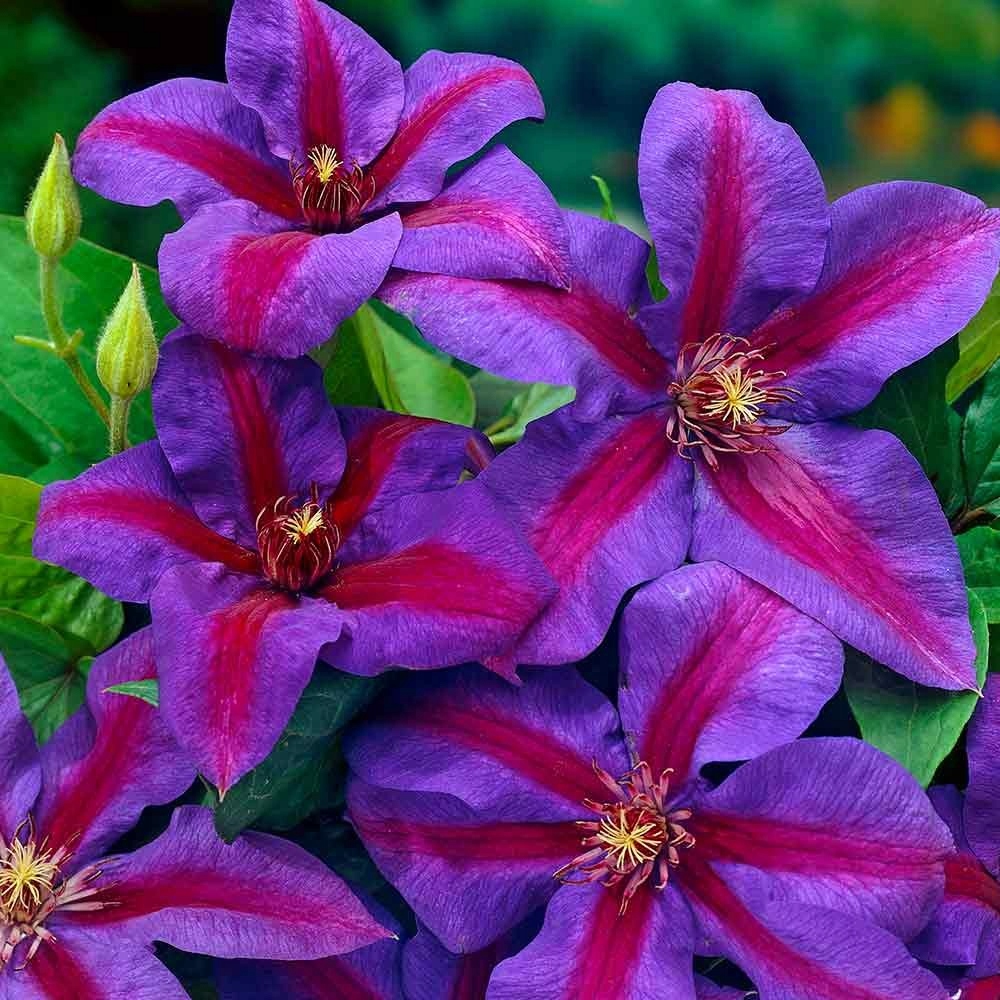
Clematis Thompson
Description of the variety
Clematis Mrs. N. Thompson is a compact, deciduous vine with a moderate growth rate. Usually, the stem grows up to 200 cm (sometimes up to 250 cm), clinging to the support with petioles. Clematis stems are woody. Flowering occurs twice: on last year's shoots - in May-June, on young ones - in September.
Flowers are large enough (14-17 cm in diameter), flat, deep purple. A purple stripe runs down the center of each sepal. The petals are elliptical, with a pointed tip and a slightly crinkled edge. The middle is dark red with yellow stamens.
Landing rules
Planting is carried out in the spring - in April-May or in the fall - in September-October. Seedlings with a closed root system can be planted in the summer, transferring them along with a lump. The autumn procedure should be carried out a month before the expected frost.
Selection and preparation of a seedling
For planting, it is better to purchase two-year-old seedlings rooted from cuttings. They should be free of dry shoots, stains and damage. Before planting, it is advisable to soak the roots in water and treat with a disinfectant.
Pick-up location
Mrs. Thompson prefers openwork partial shade. In the bright sun, its colorful flowers can fade, and in full shade, they can fade and fade. The soil needs neutral, preferably loose and fertile. The landing site should be protected from the wind and away from groundwater.
The distance from the planting pit to the walls or other perennials is 90-100 cm.
Technology:
- Dig a hole to a depth of 50-60 cm and the same diameter.
- Drainage from total brick or crushed stone is laid at the bottom.
- Garden soil is mixed with humus, compost and wood ash, add 50 g of superphosphate.
- The soil mixture is poured with a mound, the plant is placed on top, and the roots are lowered down.
- Water the seedling with a bucket of water.
- The rest of the substrate is poured, deepening the root collar by 7-10 cm.
- Install the support.
- Planting ends with another watering and mulching of the soil.
Care
Mrs. Thompson is a vibrant and exotic plant, but not at all moody. Of course, he needs to be looked after, but the care procedures are not particularly difficult. Everything a liana needs: regular watering and feeding, pruning, mulching, a garter to a support and shelter for the winter.
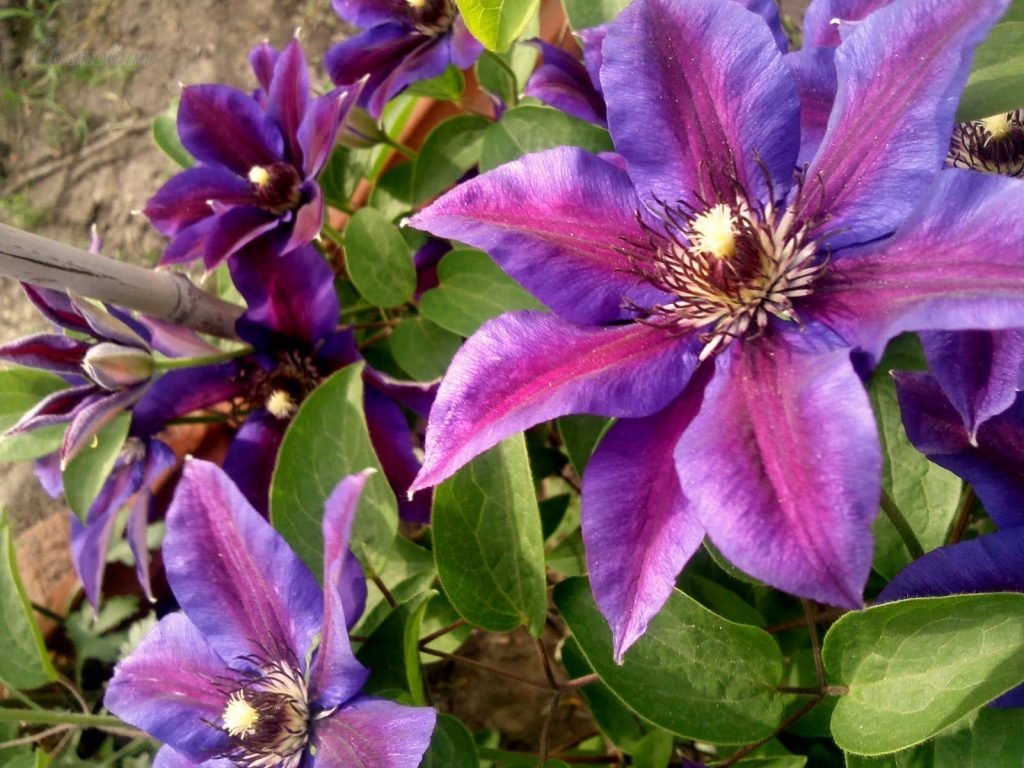
Clematis Mr. Thompson
Watering
In the first season, watering is carried out twice a week, using 3-8 liters of water per bush. In the future, it is watered less often, but more abundantly (3-4 times a month, 15-20 liters). At the same time, it is important not to get on the leaves and stems and not to allow the constant moisture of the soil.
Top dressing
In the first year after planting, the plant does not need to be fed.Further feeding is necessary for good growth and abundant flowering.
Fertilizers are applied 3-4 times a season: in the spring - nitrogen, during the budding period - complex, in August and autumn - phosphorus-potassium.
Mulching
Clematis roots are very sensitive to overheating, so they need to be mulched with a layer of 10 cm and a radius of 50-60 cm. Pine bark, decorative chips, peat, dry grass, compost are suitable as mulch.
The procedure has other advantages: it facilitates maintenance (no need to loosen and weed), reduces moisture evaporation, and prevents pests and diseases.
Garter
The liana is tied to a strong support so that the thin stems do not break from the wind and weave beautifully. The first garter is carried out immediately (after planting or removing the winter shelter in early spring), securing the bush with a cord at the very bottom.
The growing shoots are fanned and tied, not allowing them to intertwine with each other.
Trimming group and technology
Mrs. Thompson's flowers appear on the shoots of the past and the current year, which corresponds to the pruning of the 2nd group. It is held twice - in June and in autumn.
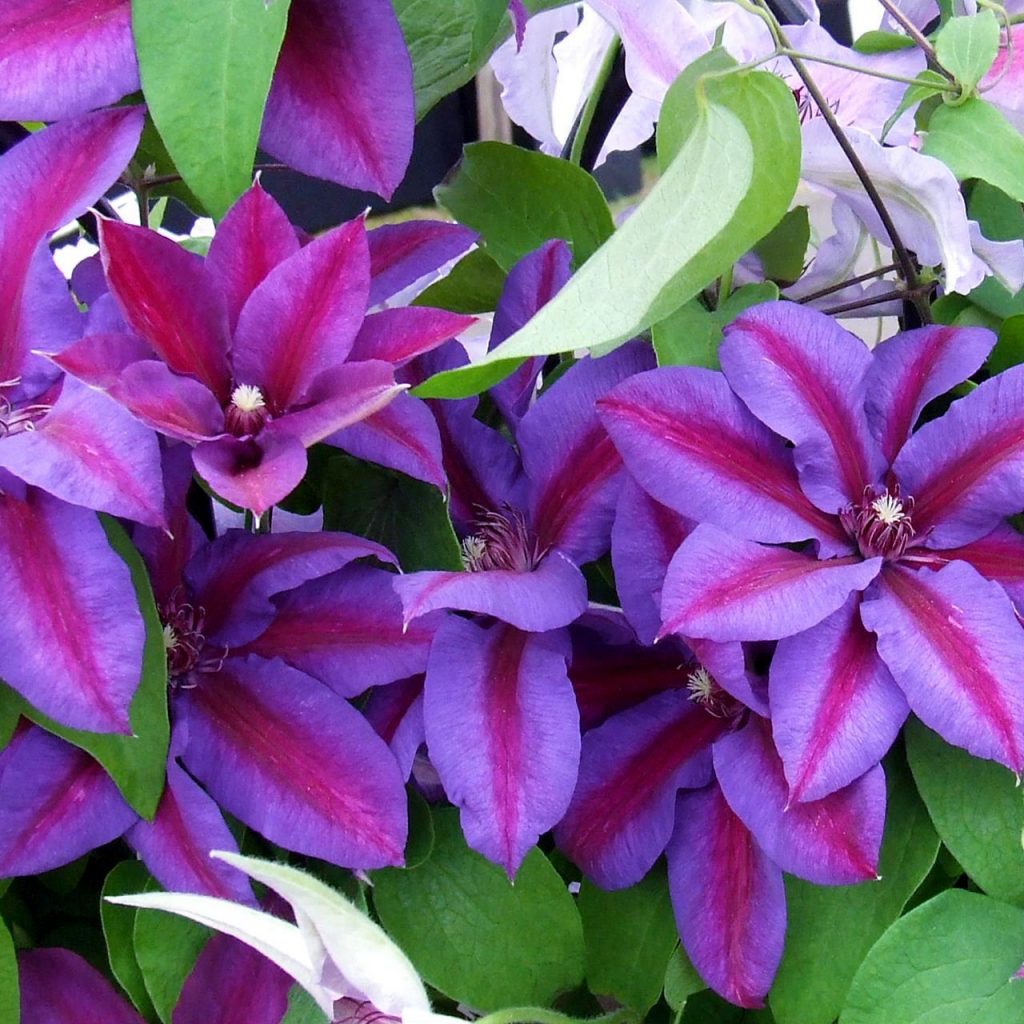
Clematis Mrs. Thompson photo and description
Technology: the stems are cut with a disinfected sharp pruner so that a bush with a height of 1-1.5 m remains. (Clematis must be cut more thoroughly every 5 years).
Preparing for winter
Despite the hardiness, Mrs. Thompson is sheltered for the winter. The covering is made from pine or spruce branches, from the risk of rodents - covered with a box.
During a thaw, melted snow can flood the roots, therefore, in the fall, soil is poured under the bush (the height of the hill is 40-50 cm).
Reproduction
Mrs. Thompson is propagated by retraction of shoots, dividing the bush and cuttings. When sowing seeds, varietal characteristics are not preserved. The most common breeding method is by cuttings.
Cuttings
A cut cut should have one node with lateral buds. It is treated with Kornevin and deepened into a two-layer substrate (the top is wet sand, the bottom is fertile soil). The container is covered from above, creating the effect of a greenhouse. The soil is regularly moistened, and the greenhouse is aired. A sign that clematis has taken root will be the awakening of the axillary buds.
Dividing the bush
Liana can be divided every 5-6 years, but not more often. The bush is dug up and divided into several parts (each must have at least one socket with a bud). Delenki are planted in an openwork partial shade, having dug up in advance, loosening and fertilizing the soil. Plants are watered three times a week.
Layers
The soil near the parent bush is dug up with ash and sand, loosened, watered. An escape is planned for rooting. Leaves are removed on it, a knot is selected and bent to the ground by this place. The stem is fixed with wire and covered with wet sand from above. With regular watering, the cuttings take root in a month and a half.
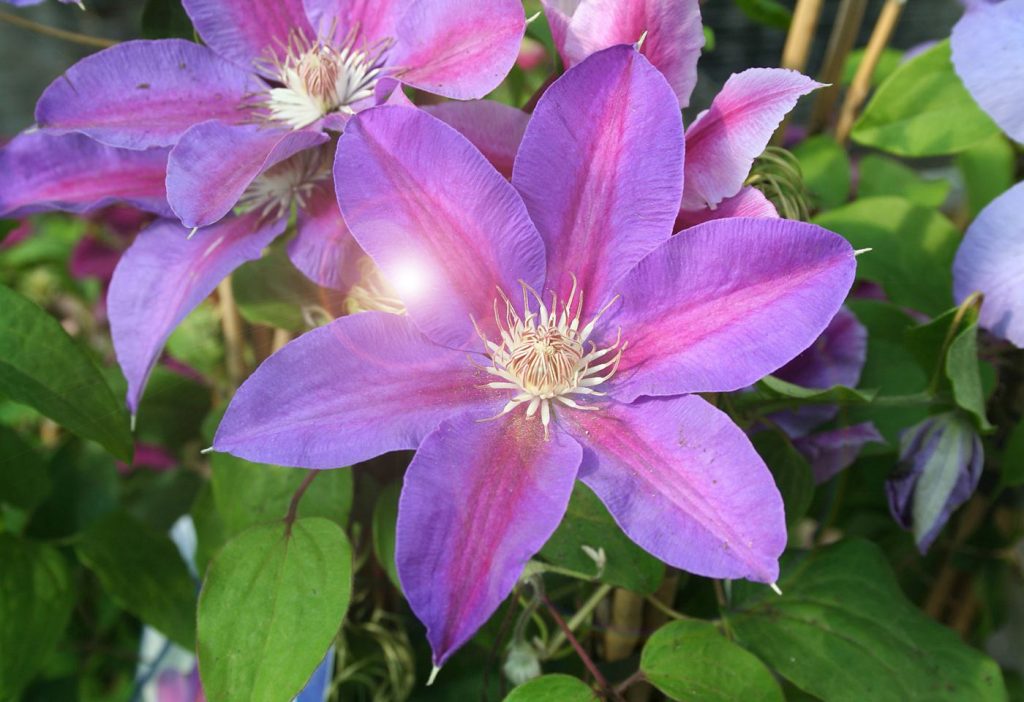
Clematis mrs thompson nursing
Diseases and pests
| Problem | Symptoms | Prophylaxis | Treatment |
| Aphid | Colonies of bugs on the underside of the leaves. The leaves dry, curl, change color. | Avoid anthills dangerously close to the bush. Plant calendula nearby (to attract ladybugs that feed on aphids). | Cut off the deformed leaves, wash the clematis with a solution of tar soap. Treat with Fitoverm. |
| Powdery mildew | White bloom, like flour, darkening of stems, stunted growth. | Avoid constant soil dampness and waterlogging. Disinfect drainage and garden tools. Conduct preventive watering with ash solution and potassium permanganate. | Remove the affected parts of the plant. Treat the bushes with a mixture of soap and copper sulfate. |
| Wilt | Shoots lose their elasticity, wither and dry out. | Adhere to the correct watering regime. Do not plant in full shade. Do not overuse nitrogen fertilizers. Disinfect inventory. | Cut off affected stems and burn. Treat the remains of the bush and the soil under it with Fundazol. |
In landscape design
Thanks to its colorful flowers and double flowering, Mrs. Thompson is often used to decorate gardens and summer cottages. The beautifully woven large-flowered clematis is ideal for vertical landscaping. He is allowed to trudge along arches, trellises, ladders, walls, fences and fruit trees, creating spectacular decorative compositions.
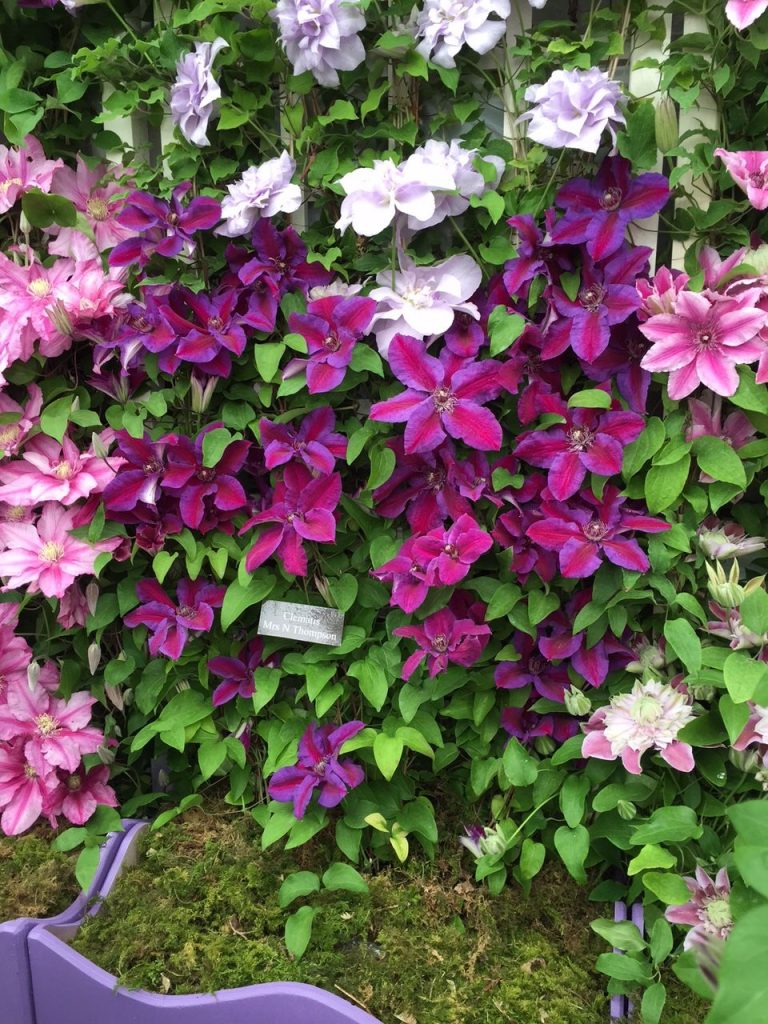
Clematis m thompson
In addition, this variety grows well in a container, which allows it to be used to decorate balconies, verandas, terraces and small courtyards without planting land. Liana is in perfect harmony with conifers and low deciduous perennials. Combinations of clematis with honeysuckle, hops, grapes look organic.
Testimonials
According to gardeners, Mrs. Thompson has a moderate growth rate and begins to bloom profusely in the third or fourth year. Liana rarely gets sick, tolerates pruning well, does not freeze in winter. The most common problem is overheating of the roots, but mulching successfully solves it.
This compact variety is often grown in wide containers, which allows the plant to be moved around as needed (exposed to light, shaded, protected from wind, etc.). Most gardeners prefer to propagate liana by cuttings. This method gives a much better chance of getting a completely healthy seedling (when dividing the bush and deflecting the shoots, diseases of the parent plant can be transmitted).

